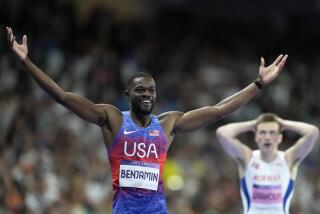U.S. Women’s Olympic Marathon Trial : Third Qualifying Spot Opens Up
- Share via
PITTSBURGH — Joan Benoit Samuelson had been riding an emotional seesaw for a month, agonizing over whether she should run the U.S. women’s Olympic marathon trial here today.
Samuelson, who won the gold medal in the inaugural women’s Olympic marathon in 1984 at Los Angeles, has been suffering back and leg problems and had pretty much decided several weeks ago to forgo the race. But in the last two weeks her training runs suddenly improved--and she was tempted.
Her decision had been a matter of intense speculation, since Samuelson is probably at least 10 minutes faster than almost any other American woman at the 26.2-mile distance. Samuelson ran the second-fastest women’s marathon in history, 2 hours 21 minutes 21 seconds, only 15 seconds slower than Norwegian Ingrid Kristiansen’s world record. If Samuelson had chosen to run the trial, her place on the team was considered a given.
But last week, she finally made up her mind.
“I’m not going,” she said. “I’m just not mentally prepared, and that’s always been my strongest point. I’ve been on a roll, but I’ve only had four weeks of training and I don’t think the Olympic trials is the place to test my fitness.”
Thus, the 15 or so American women with chances of making the team will find themselves competing for three spots instead of two.
Said Julie Isphording, a member of the 1984 team: ‘It does free up a space. I always thought she’d be the first spot, and about 15 of us would be fighting for the other two spots. I think it’s going to be a dogfight right to the end.”
Isphording, who dropped out of the 1984 Olympic marathon at the 11th mile after tearing a tendon, has had a difficult two years. She suffered a ruptured disk in her back and, as a result, lost the feeling in her right leg. She underwent major back surgery a year ago.
“I’ve been through a lot of horror,” she said. “It’s been a hard comeback, but I’m in pretty good shape now. I feel like I’ve been given back my running.”
Isphording, 26, marketing director for a Cincinnati law firm, is the only member of the 1984 team returning to run the trial. The third, Julie Brown of San Diego, has taken a leave from law school and has decided to go back to the track and concentrate on the 10,000-meters, which will make it’s Olympic debut as a women’s event in Seoul.
Lisa Larsen Weidenbach, who placed fourth in the 1984 trial and won the women’s division of the 1985 Boston Marathon--only to be sidelined with injuries shortly thereafter--said she has been running injury-free for the past 13 months.
“I’m not afraid to say I’m in the best shape of my life,” she said.
Weidenbach, 26, of Redmond, Wash., said she recently ran personal bests at the shorter distances of 10 and 15 kilometers--6.2 and 9.3 miles--an achievement that “has really boosted my confidence.”
Without Samuelson in the race, she said, “we might all be a little more assertive.”
Nancy Ditz, of Woodside, Calif., another highly regarded contender, ran 2:34:50 for seventh place in the World Championships in Rome last summer. “It was hot and a bad course, and I’m in much better shape now than I was when I ran that,” she said.
Ditz, who ran her best, 2:31:36, in 1985, said she believes she is now in sub-2:30 shape.
“I think I’m now capable of running 2:27 or 2:28,” Ditz said. “I don’t know what it’s going to take to make the team. I just have to go prepared to run my fastest race. I don’t imagine there will be a lot of people under 2:30.”
Kim Rosenquist Jones, who sprained an ankle at the World Championships, said of Sunday’s trial: “I’ve never trained as much in my life.”
Jones, a former high school sprinter, said she has increased her mileage from 70 to 90 miles a week to increase her endurance. Her best time is 2:32:31, but, like Ditz, she said she thought she was capable of a sub-2:30 effort.
The first three finishers will each receive $25,000 in prize money, a structure different from that of the men’s trial in New Jersey last week. There, first place drew $50,000; second place, $25,000 and third place, $20,000.
At this time of year in Pittsburgh, the weather can be hot and the course is not an easy one. The first seven miles are flat and fast, dangerous later on for those who go out too quickly. There are two major hills: a climb of about 170 feet that lasts a mile starting with the 11th mile, and a steep downhill between miles 22 and 24 that can be especially painful after 22 miles of pounding.
Other contenders include Maureen Custy Roben, 32, of Denver; Cathy Schiro, 20, of Boston; Debbie Raunig, 32, of Missoula, Mont.; Linda Zeman, 27, of Albuquerque, N.M.,and Sylvia Mosqueda, 22, of Alhambra, Calif.
More to Read
Go beyond the scoreboard
Get the latest on L.A.'s teams in the daily Sports Report newsletter.
You may occasionally receive promotional content from the Los Angeles Times.






